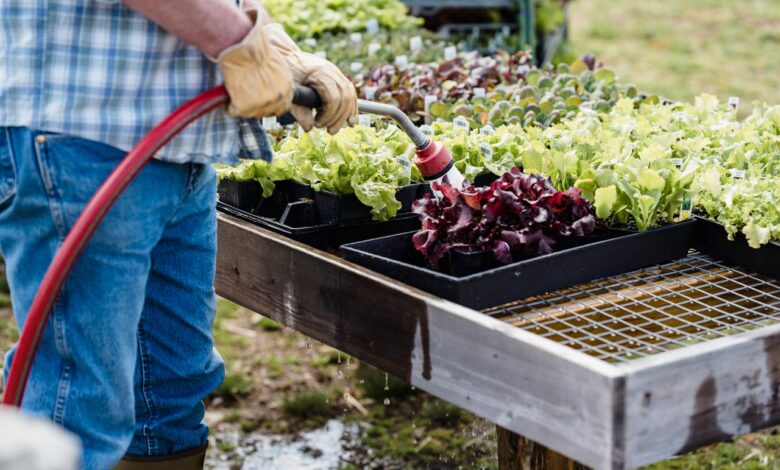Everything You Need to Start a Veggie Garden at Home

Converting a little area of your lawn into a flourishing vegetable garden can be a very fulfilling project. A few advantages include the satisfaction of picking vegetables that you have grown yourself, the chance to interact with nature, and the chance to follow sustainable practices.
Selecting the Optimal Garden Location
Selecting the appropriate site is the first step in developing a successful vegetable garden. Choosing a location that gets six to eight hours of direct sunshine every day is essential for vegetables, since they normally need enough sunlight to flourish. Vegetable gardens are often plagued by fungal infections, which can be avoided by creating an area with enough ventilation. It’s also critical to consider the location of water sources. Having easy access to water can make watering much easier and guarantee that your plants get the regular moisture they need. Furthermore, making sure that you have all the proper tools and equipment stored in a gardening shed for all your growing and sowing needs is highly recommended.
Preparing the Soil for Planting
The basis of a successful vegetable garden is good soil. To begin, do a pH and nutrient level test on the soil. Most veggies like a pH of 6.0 to 7.0, which is slightly acidic to neutral. You can get soil test kits from local agricultural extensions or garden centers. Add the required fertilizers to the soil after analyzing the findings. Composted organic matter or well-rotted manure is an excellent way to increase the drainage, fertility, and structure of soil. Better growth is facilitated by loosening the soil to a depth of around 12 inches, which makes it easier for roots to penetrate. To establish the ideal growth environment, it’s also crucial to remove weeds, pebbles, and roots. Adding organic matter to mulch via decomposition and weed suppression are some of the benefits of using organic materials like wood chips or straw.
Choosing the Right Vegetables for Your Climate
Choosing veggies that are compatible with your area’s climate is essential to a good crop. Cool-season crops, which can be sown in the early spring or autumn, such as lettuce, spinach, and broccoli, do well in colder climates. Warm-season crops, such as tomatoes, peppers, and cucumbers, are usually plante after the last frost date since they need higher soil and air temperatures. Look into the cultivars that are successful in your area. Expert gardeners or local extension offices might provide insightful information. While ancestral varieties might provide distinctive tastes and historical importance, hybrid types often offer enhanced disease resistance and higher yields. Throughout the growing season, a continuous harvest can be guarantee by spacing out the planting dates.
Implementing Effective Irrigation Techniques
Watering vegetables properly and consistently is essential to their development. Because they minimize evaporation, lower the danger of illness, and distribute water directly to the plant roots, drip irrigation systems are highly successful. A less expensive option is soaker hoses, which distribute water evenly all the way along their length. Timer integration is a simple technique that enables both approaches to automate irrigation, guaranteeing that your garden is consistently irrigate even during your absence. Enhancing drought tolerance, heavy watering promotes deeper root growth. Generally, thorough watering at fewer intervals is preferable to shallow watering regularly. Watering in the early morning minimizes the danger of fungal infections by enabling leaves to dry rapidly and allowing plants to absorb moisture before the heat of the day.
Managing Pests and Diseases Naturally
A thriving vegetable garden needs constant watchfulness on pests and illnesses. The main goals of integrated pest management (IPM) techniques are natural approaches for monitoring, control, and prevention. Pest populations can be manage by promoting beneficial insects like ladybugs and predatory beetles. The danger of soil-borne illnesses and insect infestations can be decrease by planting a variety of vegetables and switching up your crops every season. Another useful tactic is companion planting, which involves growing certain plants next to one another to promote development and ward against pests. Marigolds, for instance, can be plant amid crops to ward off nematodes and other pest insects. Plant health is maintain by routinely looking for indications of pests or disease and acting quickly to remove afflicted leaves or apply natural remedies like neem oil.
Conclusion
Planting a vegetable garden requires careful preparation, from picking a good spot and preparing the soil to selecting appropriate veggies, setting up efficient irrigation, controlling pests organically, and becoming an expert at collecting and storing your own. By adhering to five crucial principles, you can grow a fruitful and satisfying garden that produces delicious, fresh vegetables and encourages a strong connection to nature.



